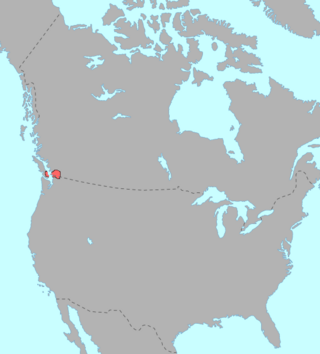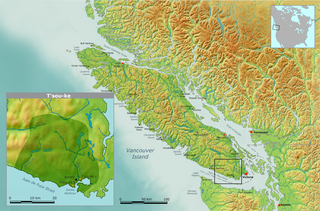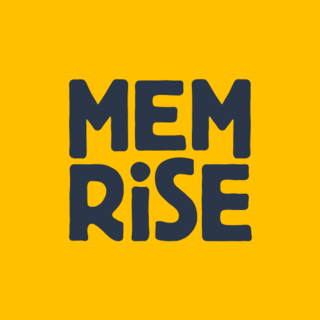Related Research Articles

Saanich is a district municipality on Vancouver Island in British Columbia, within the Greater Victoria area. The population was 117,735 at the 2021 census, making it the most populous municipality in the Capital Regional District and Vancouver Island, and the eighth-most populous in the province. The district adopted its name after the Saanich First Nation, meaning "emerging land" or "emerging people". The district acts as a bedroom community immediately to the north of Victoria, British Columbia.

The Kʼómoks or Kʼomoks, usually known in English as the Comox, are an indigenous group of Coast Salishan-speaking people in Comox, British Columbia and in Toba Inlet and the Malaspina Peninsula areas of the British Columbia mainland across Georgia Strait. They historically spoke the Komox language (Comox-Sliammon), and were divided in two main dialect and tribal groupings, which are known by academics as Island Comox and Mainland Comox.
Language revitalization, also referred to as language revival or reversing language shift, is an attempt to halt or reverse the decline of a language or to revive an extinct one. Those involved can include linguists, cultural or community groups, or governments. Some argue for a distinction between language revival and language revitalization. There has only been one successful instance of a complete language revival: that of the Hebrew language.

The Saanich or W̱sáneć are indigenous nations from the north coast of the Gulf and San Juan Islands, southern Vancouver Island and the southern edge of the Lower Mainland in British Columbia.

Halkomelem is a language of various First Nations peoples of the British Columbia Coast. It is spoken in what is now British Columbia, ranging from southeastern Vancouver Island from the west shore of Saanich Inlet northward beyond Gabriola Island and Nanaimo to Nanoose Bay and including the Lower Mainland from the Fraser River Delta upriver to Harrison Lake and the lower boundary of the Fraser Canyon.

The Stó꞉lō, alternately written as Sto꞉lo, Stó:lô, or Stó:lõ, historically as Staulo, Stalo or Stahlo, and historically known and commonly referred to in ethnographic literature as the Fraser River Indians or Lower Fraser Salish, are a group of First Nations peoples inhabiting the Fraser Valley and lower Fraser Canyon of British Columbia, Canada, part of the loose grouping of Coast Salish nations. Stó꞉lō is the Halqemeylem word for "river", so the Stó꞉lō are the river people. The first documented reference to these people as "the Stó꞉lō" occurs in Catholic Oblate missionary records from the 1880s. Prior to this, references were primarily to individual tribal groups such as Matsqui, Ts’elxweyeqw, or Sumas.

The T'sou-ke Nation of the Coast Salish peoples, is a band government whose reserve community is located on Vancouver Island, in the province of British Columbia, Canada. In February 2013, the T'sou-ke Nation had 251 registered members, with two reserves around the Sooke Basin on the Strait of Juan de Fuca at the southern end of Vancouver Island, with a total area of 67 hectares. The T'Souk-e people are the namesake of the town of Sooke, British Columbia and its surrounding harbour and basin.

The Kutenai language, also Kootenai, Kootenay, Ktunaxa, and Ksanka, is the native language of the Kutenai people of Montana and Idaho in the United States and British Columbia in Canada. It is typically considered a language isolate, unrelated to the Salishan family of languages spoken by neighboring tribes on the coast and in the interior Plateau. The Kutenai also speak ʔa·qanⱡiⱡⱡitnam, Ktunaxa Sign Language.

Mount Douglas, usually referred to as Mount Doug by locals, is a prominent, 225 m (738 ft) hill in Saanich, British Columbia. It is located in (PKOLS) Mount Douglas Park in the municipality of Saanich.
Nisga’a is an indigenous language of northwestern British Columbia. It is a part of the language family generally called Tsimshianic, although some Nisga'a people resent the precedence the term gives to Coast Tsimshian. Nisga’a is very closely related to Gitxsan. Indeed, many linguists regard Nisga’a and Gitksan as dialects of a single Nass–Gitksan language. The two are generally treated as distinct languages out of deference to the political separation of the two groups.

Saanich is the language of the First Nations Saanich people in the Pacific Northwest region of northwestern North America. Saanich is a Coast Salishan language in the Northern Straits dialect continuum, the varieties of which are closely related to the Klallam language.
An indigenous language, or autochthonous language, is a language that is native to a region and spoken by its indigenous peoples. Indigenous languages are not necessarily national languages but they can be; for example, Aymara is both an indigenous language and an official language of Bolivia. Also, national languages are not necessarily indigenous to the country.
The Shuswap language is a northern Interior Salish language traditionally spoken by the Shuswap people of British Columbia. An endangered language, Shuswap is spoken mainly in the Central and Southern Interior of British Columbia between the Fraser River and the Rocky Mountains. According to the First Peoples' Cultural Council, 200 people speak Shuswap as a mother tongue, and there are 1,190 semi-speakers.
The First Peoples' Cultural Council (FPCC) is a First Nations governed Crown Corporation of the province of British Columbia, Canada. It is based in Brentwood Bay, British Columbia on Tsartlip First Nation. The organization was formerly known as the First Peoples' Heritage, Language and Culture Council, but shortened its name in 2012.
Malahat First Nation is a Coast Salish First Nations community of W̱SÁNEĆ representing approximately 350 members with two reserve lands located on the western shore of Saanich Inlet, Vancouver Island in British Columbia, Canada. The Malahat First Nation is one of many nations within the Coastal Salish group that live on their traditional lands. The Coastal Salish are Indigenous to the Northwest mainland, coast, and islands. The Malahat First Nation is a member nation of the Naut'sa mawt Tribal Council and was the ninth First Nation in Canada to be certified by the First Nations Financial Management Board. The ancestral languages of Malahat Nation are Hul̓q̓umín̓um̓ and SENĆOŦEN. The Hul̓q̓umín̓um̓ or Halkomelem language is spoken in Washington State and British Columbia and is within the Coastal Salish language family. Currently it is being revitalized, as it is mainly spoken by elders in the community. The Chief of Malahat Nation is George Harry. George served on the council for four years before being elected as Chief on June 10, 2019.

Memrise is a British language platform that uses spaced repetition of flashcards to increase the rate of learning. It is based in London, UK.
The Master-Apprentice Language Learning Program is a strategy used in language revitalization, in which committed language learners (apprentices) work with fluent speakers (mentors) to "create their own oral language-immersive context through daily activities, cultural practices, and community involvement". Originally introduced in the 1992, the method is increasingly popular across North America and around the world.

Marianne Boelscher Ignace is a Canadian linguist and anthropologist. Married into the Shuswap people, she is a Full professor in the departments of Linguistics and Indigenous Studies at Simon Fraser University (SFU), and Director of SFU's Indigenous Languages Program and First Nations Language Centre. In 2020, Ignace was elected a Fellow of the Royal Society of Canada for her work in revitalizing and preserving indigenous languages.

Ditidaht Kids is a Canadian mobile game developed by the language department of the Ditidaht Community School (DCS), who are members of the Ditidaht First Nation in Vancouver Island, British Columbia. The game was created to teach Ditidaht children aged 3 to 6 about their language, territory, traditions, and culture in preparation for them attending kindergarten at the DCS. Ditidaht Kids involves an interactive canoe journey through Ditidaht territory. The game was funded by the First Peoples' Cultural Council (FPCC) and the Ditidaht Community School collaborated with elder teachers, knowledge keepers, fluent speakers, historians, researchers, voice actors, songwriters, children, and parents to develop the game. Ditidaht Kids was released on September 23, 2021, and is available on Android and iOS. As of November 2021, the game has been downloaded over 2,000 times.
References
- 1 2 Llanes-Ortiz, Genner (2023). Digital Initiatives For Indigenous Languages. UNESCO. p. 113. ISBN 978-92-3-100617-3 . Retrieved 21 February 2024.
- 1 2 3 Arrais, Pedro (Sep 24, 2023). "Vital People: Online portal gives voice to Indigenous languages". Times Colonist. Retrieved 21 February 2024.
- 1 2 Maffi, Luisa (Winter 2010). "FirstVoices: Bringing Indigenous Language Legacies into the Future" (PDF). Langscape. Vol. II, no. 7. Terralingua. Retrieved 21 February 2024.
- 1 2 3 4 5 6 "FirstVoices Fact Sheet". FirstVoices Knowledge Base. First Peoples' Cultural Council. Retrieved 21 February 2024.
- ↑ Wallach, Omri (20 June 2018). "Cloud-based software deployed for First Nations language preservation". Business In Vancouver. Glacier Media Group. Retrieved 21 February 2024.
- ↑ "About FirstVoices". FirstVoices. Retrieved 21 February 2024.
- 1 2 "FirstVoices — Introduction". Relational Lexicography. University of British Columbia. Retrieved 21 February 2024.
- 1 2 "FirstVoices celebrates International Mother Language Day with the launch of a new version of its free, open-source, Indigenous language platform". Financial Post. 21 February 2024. Retrieved 21 February 2024.
- ↑ "BC Sans Typeface". gov.bc.ca. Government of British Columbia. Retrieved 21 February 2024.
- ↑ "Language Technology Program". fpcc.ca. First Peoples' Cultural Council. Retrieved 21 February 2024.
- ↑ Brennan, William (June 12, 2013). "A Lifeline for Endangered Languages". The New Yorker. Retrieved 26 February 2024.
- ↑ Hui, Stephen (4 May 2012). "Geek Speak: Jared Deck, Sto:lo Shxweli Halq'eméylem Language Program". The Georgia Straight. Retrieved 26 February 2024.
- ↑ "FirstVoices Language Tutor Provides New First Nations Language Teaching Tool". Nation Talk. Retrieved 26 February 2024.
- ↑ Depner, Wolf (30 September 2021). "Saanich Peninsula resident John Elliott is a leading voice in revitalizing language, culture". Saanich News. Retrieved 21 February 2024.
- ↑ Perrier, Cameron (18 May 2016). "Keyboard app brings Indigenous languages to mobile". CBC News. CBC. Retrieved 21 February 2024.
- ↑ Gessner, Suzanne; Parker, Aliana; Herbert, Tracey (2022). Report on the Status of B.C. First Nations Languages (Fourth ed.). First Peoples' Cultural Council. ISBN 978-1-9990269-1-2.